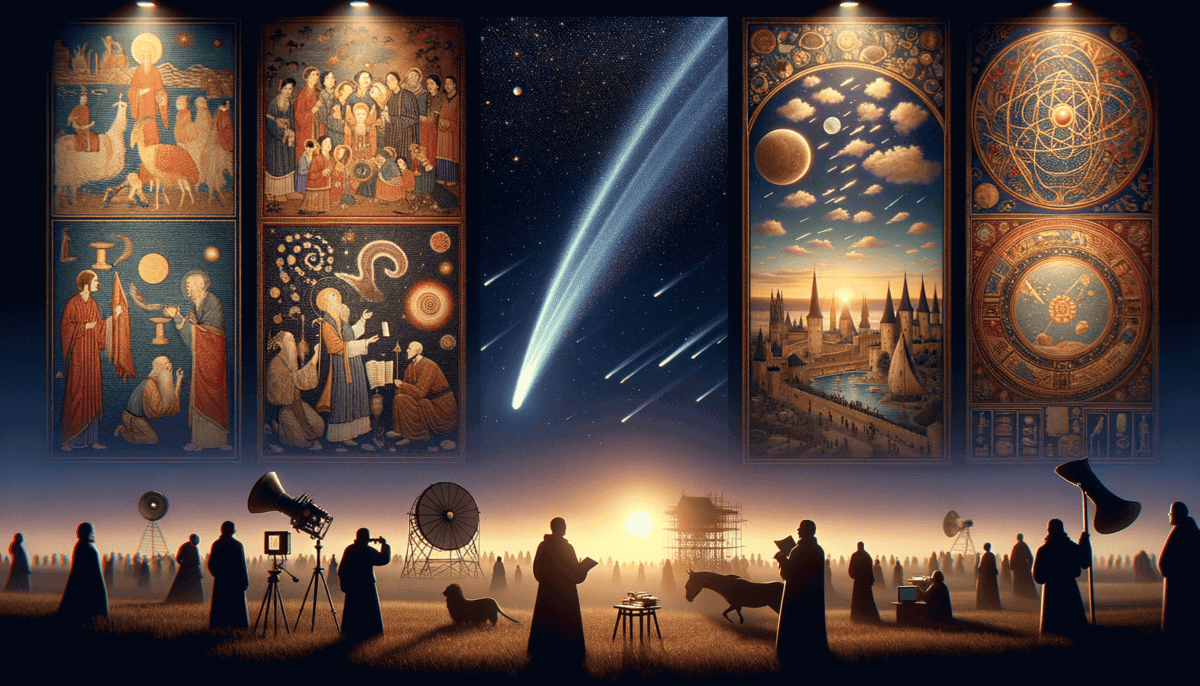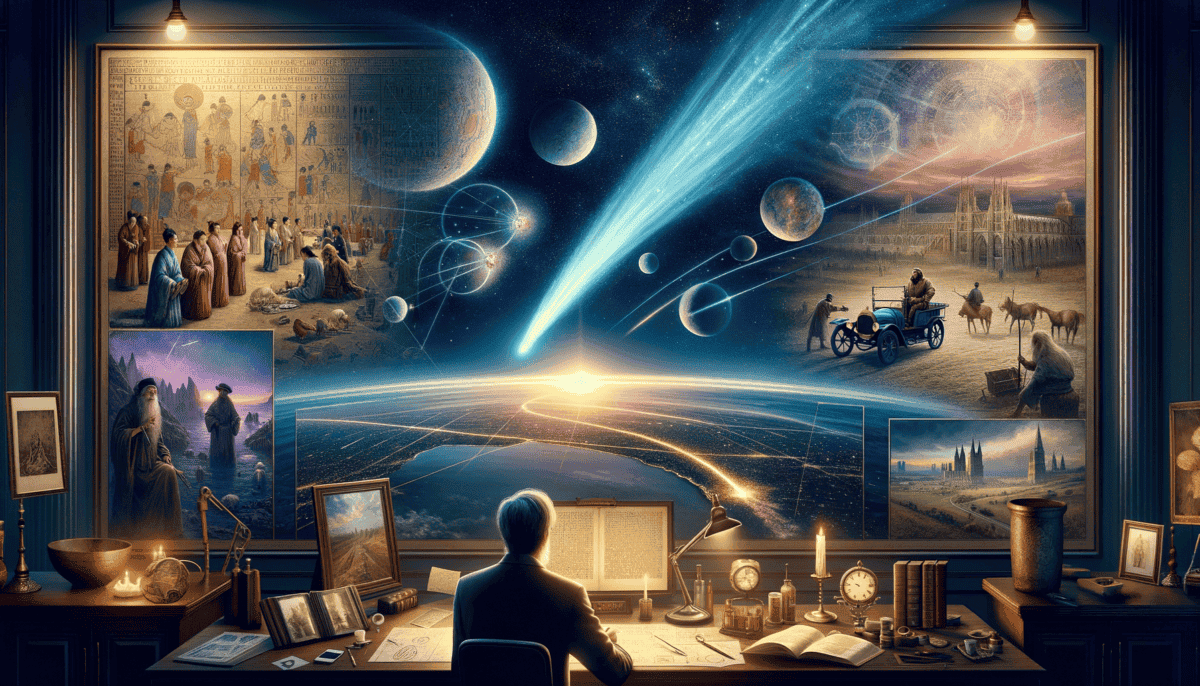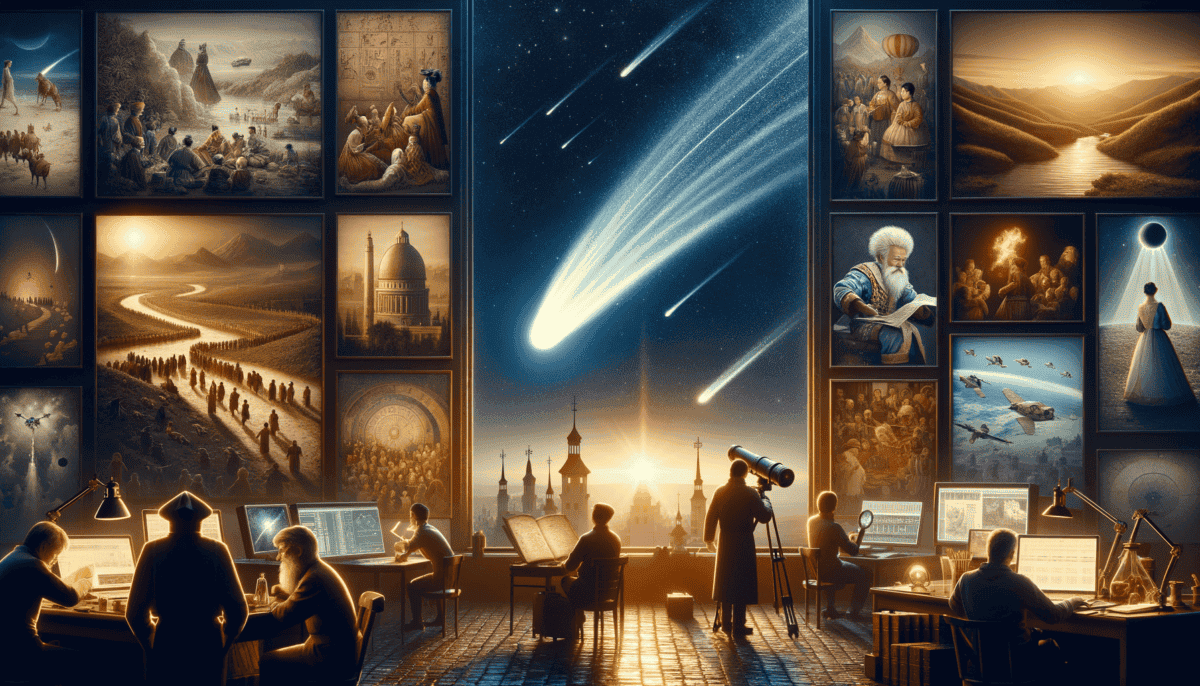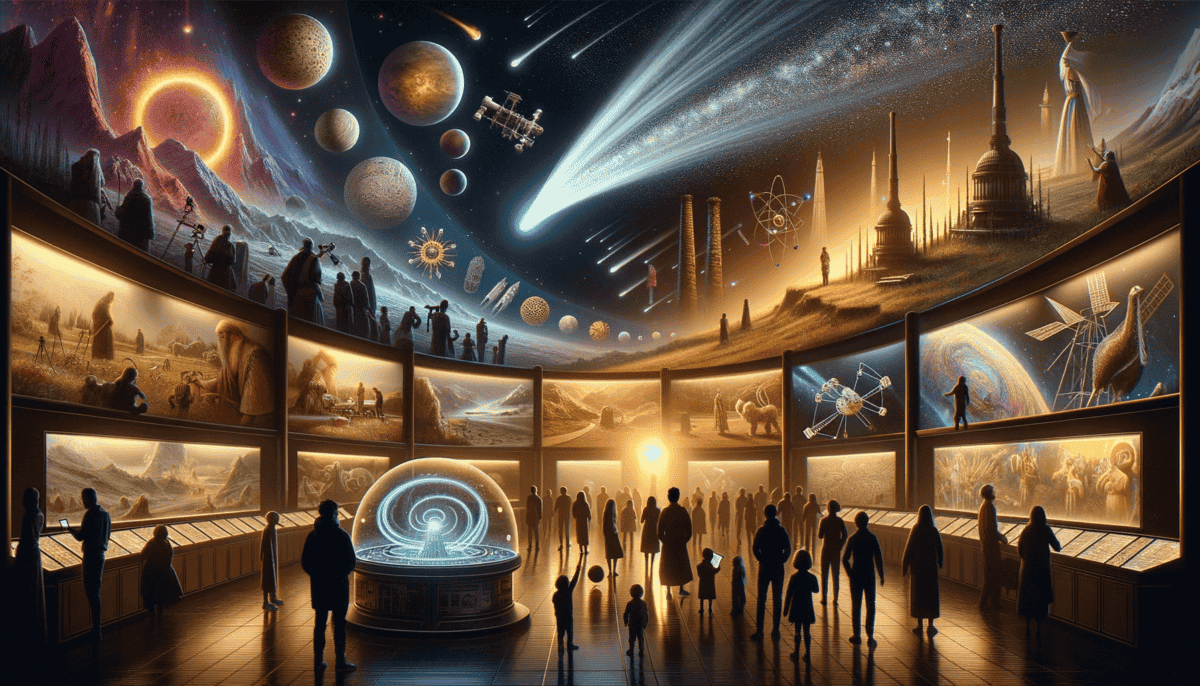A Light in the Ancient Sky
Long, long ago in China, when dragons danced in stories and kings lived in great palaces, something amazing happened in the night sky.
Li Wei, a young sky watcher, sat on a hill with his grandfather. They looked up at the stars every night. But this night was different.
"Look!" Li Wei pointed up. A bright light streaked across the dark sky. It had a long, glowing tail that reminded him of a silver dragon.
His grandfather smiled and pulled out a special scroll. "This is very important, Li Wei. We must write down everything we see."
Li Wei watched as his grandfather painted beautiful Chinese letters on the scroll. The mysterious light stayed in the sky for many days. Other people in their village saw it too.
"What is it, Grandfather?" Li Wei asked.
"Some call it the 'Broom Star' because its tail looks like it's sweeping the sky," his grandfather explained. "It comes to visit us every 76 years."
In other parts of the world, people had different ideas about the bright visitor:
• The Babylonians thought it was a message from their gods
• Greek sailors used it to help find their way at sea
• Egyptian priests wrote about it in their temple walls
• Native Americans saw it as a spirit arrow in the sky
The night sky glowed brighter as Li Wei and his grandfather kept watching. They didn't know then that people would keep watching this same light for thousands of years.
"Will I see it again?" Li Wei asked hopefully.
His grandfather shook his head. "This visitor takes a very long journey through the stars. But your children's children might see it one day."
Li Wei helped his grandfather roll up the scroll carefully. They had become part of something big – they were some of the first people to write down seeing what we now call Halley's Comet.
“Remember, Li Wei,” his grandfather said, “whenever you see something new in the sky, write it down. That’s how we learn and share with people who come after us.”
That night, as Li Wei lay in bed, he imagined the great silver dragon swimming through the stars. He didn't know that his grandfather's careful notes would help people thousands of years later understand this mysterious light in the sky.
The comet continued its journey across the ancient world. More people would see it and write about it. But it all started with sky watchers like Li Wei and his grandfather, looking up with wonder at the mysterious light that visited Earth.
As the comet faded away into the darkness, it carried with it the dreams and stories of all who had seen it. But it would return, again and again, to amaze new generations of sky watchers.
The Tapestry’s Tale
The year was 1066, and something magical lit up the skies over England. Young Thomas, a weaver’s son, stood in awe with his mother as they watched the bright visitor in the night sky.
“Mother, what is that bright light with the long tail?” Thomas asked, pointing up.
“That, my dear, is what people call the Great Comet,” his mother replied, her fingers working quickly at her embroidery. “Queen Matilda wants it sewn into her special tapestry.”
Thomas watched as his mother worked on her part of the giant tapestry. Her needle danced through the cloth, creating a bright star with a flowing tail.
“Some say it’s a sign from God,” his mother whispered. “Others think it means big changes are coming to our land.”
All across Europe, people had different ideas about what the comet meant:
• Kings thought it was a sign they would win battles
• Farmers hoped it meant good crops would grow
• Church leaders said it was a message from heaven
• Common people worried it might bring bad luck
Night after night, the comet blazed overhead. Thomas helped his mother gather colored thread to show its bright glow in the tapestry.
“Look how I made it shine,” his mother said, holding up her work. The comet on the cloth seemed almost as bright as the real one in the sky.
People came from far away to see the comet. They brought stories about what it might mean. Some were scared, but Thomas thought it was beautiful.
“Will it stay forever?” Thomas asked hopefully.
“No, dear one,” his mother smiled. “It’s like a traveling friend who visits for a short time, then goes away on a long journey.”
When the tapestry was finished, it showed the comet big and bright above King Harold’s head. Thomas felt proud knowing his mother helped make this special picture.
Many years later, scientists would learn this was the same comet the Chinese saw. It even had the same name – Halley’s Comet!
The medieval people didn’t understand what the comet really was. But they knew it was important enough to sew into their biggest, most beautiful tapestry.
“Remember this moment,” Thomas’s mother said as they worked. “Someday, your grandchildren might see this same light in the sky.”
As the comet faded away that year, it left behind more than just memories. It left its picture in the famous Bayeux Tapestry, where people can still see it today.
Little did Thomas know that the bright visitor would keep coming back, connecting people across time just like the stitches in his mother’s tapestry connected its story.
Stargazing Scholar
The sky was different tonight. Edmund Halley knew it the moment he looked up. The young scientist adjusted his telescope, his hands shaking with excitement.
“Father, come quickly!” Edmund called out. “I’ve found something amazing!”
Edmund spent many nights watching the stars. But this night in 1682 was special. He saw a bright light with a long tail moving across the sky.
“It’s like a star that decided to go for a walk,” Edmund told his friend Isaac Newton the next day.
Edmund was curious. He wanted to know more about this moving star. He started looking through old books and papers. He found something exciting:
People saw similar bright lights in the sky in:
• 1531
• 1607
• 1682
“These lights show up about every 76 years,” Edmund said to himself. He got out his pencil and started doing math.
His friend Isaac Newton had figured out how things move in space. Edmund used these ideas to solve the mystery.
“It’s the same bright visitor!” Edmund jumped up from his desk. “It’s not different comets – it’s the same one coming back again and again!”
Edmund worked hard to prove his idea. He made lots of calculations. Sometimes he got tired, but he never gave up.
Edmund made a bold prediction: “The comet will come back in 1758!”
Some people didn’t believe him. How could anyone know what would happen in the sky so many years later?
“Just wait and see,” Edmund said with a smile. He knew he wouldn’t be alive to see it himself, but he was sure he was right.
And guess what? He was! The comet came back right when he said it would. People were amazed!
To honor Edmund’s amazing discovery, scientists named the comet after him. That’s why we call it Halley’s Comet today!
Edmund’s work changed how we think about comets. He showed they weren’t random or magical – they follow paths we can predict.
Every time Halley’s Comet returns, people remember the curious boy who loved looking at stars and grew up to solve one of space’s biggest mysteries.
“Keep watching the skies,” Edmund would say. “There’s always something new to discover up there!”
Sky Fever
The year was 1910, and everyone was looking up! Halley’s Comet was coming back to visit Earth, just like Edmund Halley said it would.
“Extra! Extra! Giant comet heading toward Earth!” shouted Jimmy, a young newspaper boy on the streets of New York. People rushed to buy papers, their eyes wide with wonder and worry.
Some folks were scared. Others were excited. Everyone was talking about it!
“Mama, will the comet hurt us?” asked little Sarah, clutching her teddy bear.
“No, sweetie,” her mother smiled. “It’s just putting on a light show for us!”
Scientists got ready to study the comet. They had better telescopes than ever before! Some even took the first photos of Halley’s Comet.
But not everyone was so calm. Some people got very scared when they heard the comet’s tail had poison gas in it.
Here are some of the funny things people did to get ready for the comet:
• Wore comet masks
• Sealed their windows with paper
• Had comet parties on their roofs
• Made special comet candy
“Look!” shouted Tommy from his backyard. “I can see it!” The comet appeared like a bright brush stroke across the night sky.
People all over the world watched in amazement. The comet’s tail stretched across the sky like a giant glowing ribbon.
Scientists learned new things about the comet. They found out it was made of:
✨ Ice
✨ Dust
✨ Frozen gases
“It’s like a dirty snowball flying through space!” explained Professor Wilson to his excited students.
Even Mark Twain, the famous writer, had a special connection to the comet. He was born when it appeared in 1835.
“I came in with Halley’s Comet,” Mark Twain said. “It’s coming again next year, and I expect to go out with it!”
And he did! Mark Twain died in 1910, just one day after the comet passed by Earth.
When the comet finally said goodbye, people had lots of amazing stories to tell. They had seen something that only comes around every 76 years!
Little did they know, the next time Halley’s Comet would visit, humans would send spacecraft to meet it in space!
Space Race to Meet Halley
The year was 1986, and something amazing was about to happen. Scientists from all over the world were getting ready to say “hello” to our old friend, Halley’s Comet – but this time with spaceships!
“We’re going to take pictures of the comet up close!” Dr. Sarah Chen told her excited team at Mission Control. “No one has ever done this before!”
The spacecraft had special names:
• Giotto from Europe
• Vega 1 and 2 from Russia
• Suisei and Sakigake from Japan
Little Bobby watched the news with his dad. “How close will the spaceships get to the comet?” he asked.
“The bravest spacecraft, Giotto, will fly right through the comet’s dusty tail!” his dad explained. “It’s like driving through a space car wash made of stardust!”
The whole world watched and waited. Would the spacecraft survive their close meeting with Halley’s Comet?
“Look at these pictures!” gasped Dr. Chen. The images showed the comet’s heart – a potato-shaped chunk of ice and rock shooting out jets of gas like cosmic fountains.
The spacecraft learned many new things about the comet:
✨ It was bigger than a city
✨ It shot out tons of water every second
✨ It spun around like a top
Back on Earth, people gathered to watch the comet in the sky. It wasn’t as bright as in 1910, but it was still special.
“Why does it look different this time?” asked Maria, peering through her telescope.
“Each time the comet visits, it loses a little bit of itself,” her science teacher explained. “Like a snowman slowly melting in the sun.”
The brave little spacecraft Giotto got very close to the comet – closer than anyone had ever been! But the comet’s dust hit its camera, like cosmic sandpaper.
Scientists learned more about Halley’s Comet in 1986 than in all its past visits combined. They discovered it was like a giant cosmic snowball having a party in space, throwing off sparkles of ice and dust.
As the comet zoomed away, people started thinking about its next visit. “When will it come back?” asked Bobby.
“In 2061,” his dad smiled. “Maybe you’ll be a scientist helping to study it then!”
The 1986 mission showed how working together could help us learn amazing things about space. Now, scientists were already dreaming about what they might discover when Halley’s Comet returns next time.
Dreams of Tomorrow’s Comet
The year is 2023, and all around the world, scientists are already getting excited. They’re planning for something special that will happen in 2061 – the return of Halley’s Comet!
In her classroom, Ms. Rodriguez shows her students pictures from the 1986 visit. “Who wants to help study the comet when it comes back?” she asks. Every hand shoots up! ♂️
“I’ll build a super-fast spaceship!” says Tommy.
“I want to take pictures with special space cameras!” adds Lucy.
Scientists are already making big plans for 2061. They’re building better telescopes and faster spacecraft. Some cool things they want to do:
• Send robots to collect pieces of the comet
• Take super clear pictures of its icy core
• Study its sparkly tail up close
• Maybe even land on its surface!
“Will the comet look different next time?” asks Maria, looking at old pictures.
“Yes,” explains Dr. Chen, now older and wiser. “Each trip around the Sun makes the comet a little smaller. It’s like a snowball that loses some snow each time it passes by.”
But even though the comet changes, it still has more secrets to share. Scientists think it might tell us about how our solar system was born!
Little Bobby from 1986 is now Dr. Robert, teaching astronomy at a university. “When I was your age,” he tells his students, “I watched Halley’s Comet with my dad. In 2061, I’ll watch it with my grandchildren!”
The story of Halley’s Comet is like a beautiful circle. From ancient Chinese sky-watchers to medieval artists, from Edmund Halley’s clever math to brave spacecraft in 1986, each generation adds new pages to its story.
And now, it’s almost time for a new chapter. Young astronomers are dreaming up new ways to study our faithful cosmic friend. They know that somewhere out there, Halley’s Comet is slowly making its way back to us.
As the sun sets, a young girl named Sophie looks up at the stars. “Somewhere up there,” she whispers, “our comet is coming home.” And just like those who watched before her, she dreams of the day when Halley’s Comet will paint the sky with its glowing tail once again.






